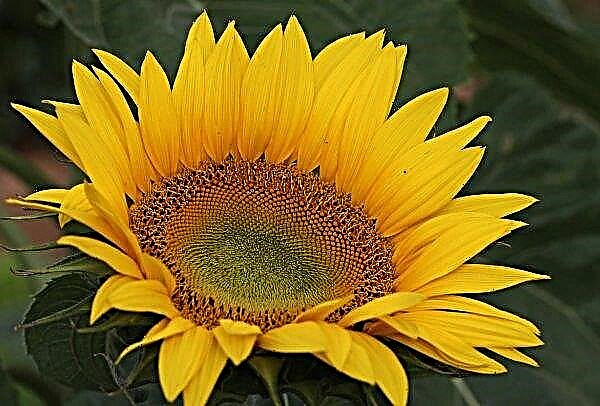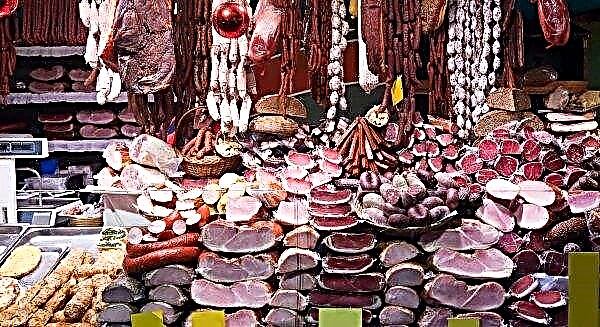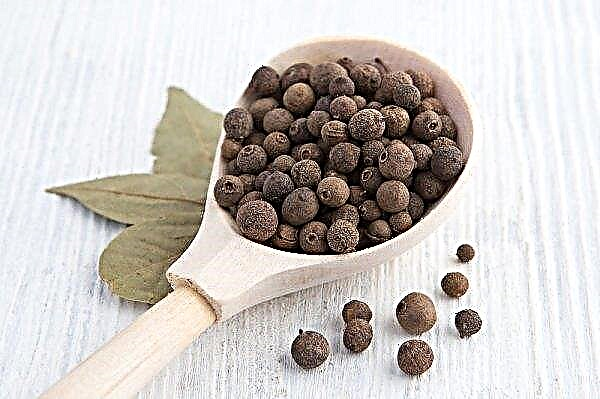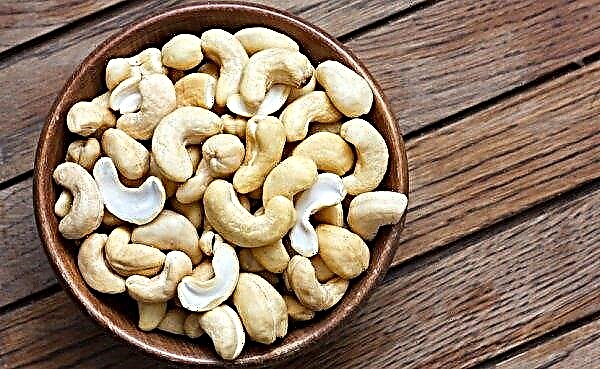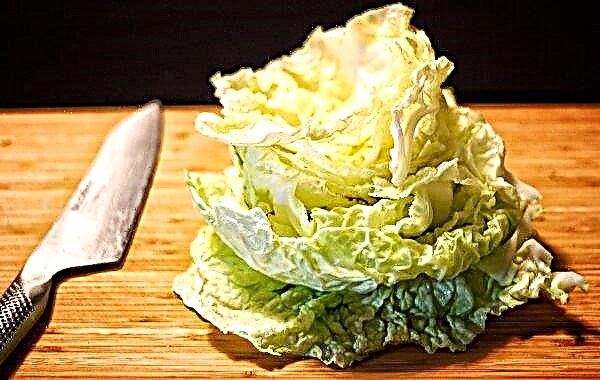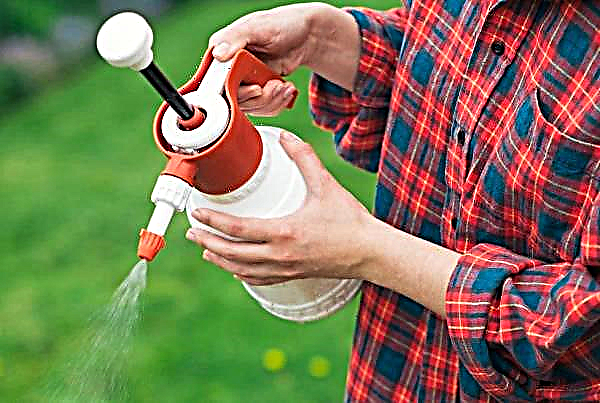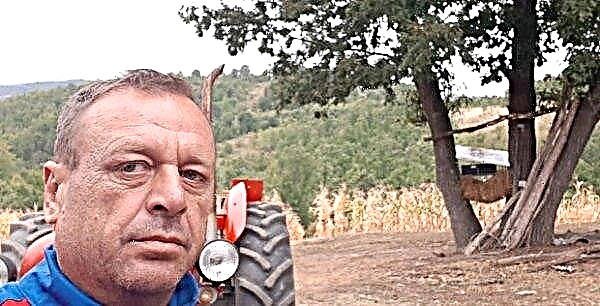The tomato variety “bull’s heart” has long been loved by Russian summer residents, and you can meet it quite often. There is nothing surprising in the popularity of such tomatoes, but to make sure of the well-deserved attention and fairness of high quality ratings, it’s enough to learn more about the characteristics of the variety.
Description and characteristics of the variety
“Bull’s heart” refers to a group of mid-ripening tomatoes, since about 120 days elapse from seedling to harvesting the first crop. The variety was introduced into the State Register in 2003 and has since been recommended for cultivation both in greenhouse conditions and in open beds. With good care from one greenhouse bush, you can collect up to 10 kg of the crop, and from the street - no more than 4 kg.

As for the external characteristics of the plant, they are expressed in the following characteristics:
- bush height - 1.5–2 m;
- leaves are green, medium in size;
- inflorescence is simple;
- fruits - with a thin skin, of various shapes, but mainly heart-shaped, weighing up to 800 g;
- the pulp is medium juicy, with a large number of dry impurities and a minimum number of veins (seed chambers are few and they are all in close proximity to the peel);
- the skin color is dark red (almost black), pink, yellow (minusinskaya yellow variety), sometimes reddish with an orange or gold hue).
Important! WITHort copes with infectious and bacterial ailments, but still often suffers from late blight. Therefore, even at the stage of planting planning, it is necessary to take care of proper prevention of this disease: select a suitable site for planting (on which solanaceous plants were not grown last year), sow siderat plants and prepare preparations for the preventive treatment of planted bushes.
Pros and cons of the variety
"Bull's heart" has a large number of undeniable advantages, which make it so popular among gardeners in many countries.
- The advantages of cultivating varieties are:
- high yields;
- good taste data;
- friendly formation of ovaries;
- the ability to grow tomatoes from independently harvested seeds;
- good transportability;
- a small amount of green mass, limiting the spread of fungal ailments.

- However, along with the listed advantages, the described tomato variety has some disadvantages:
- low resistance to late blight and some other diseases;
- the need for frequent top dressing with mineral fertilizers;
- mandatory formation and tying of bushes to a support;
- the possibility of cracking fruits (for some reason, a thin peel is often considered the most serious drawback when growing such tomatoes).
Features of planting and growing
The described tomatoes can be grown in several ways at once: for seedlings (with further transplantation to an open area) and in a greenhouse where plants can remain until the harvest (or until they grow up and are strong enough for transplanting). In any case, the ideal temperature for growing in the initial stages will be + 22 ... + 23 ° C, with a possible further decrease to + 16 ... + 18 ° C. Humidity in the room or on the street should not be higher than 65–70%. Each of the possible cultivation options may differ in certain nuances.

In the open ground
Sowing seeds immediately in open soil is a thankless task, so many tomatoes are sown first for seedlings. "Bull's heart" was no exception, therefore, first of all, it is necessary to do the preparation and sowing of seeds at home. After soaking in a weak solution of potassium permanganate and further washing with clean water, the treated seed is deepened into the soil by 3 cm, maintaining an interval between adjacent plants of 2-3 cm. As soon as the first two true leaves appear, the seedlings are dived and fed with complex fertilizers.
Tomatoes can be transplanted into the open ground in early May (that is, at two months old seedlings), when a more or less stable temperature is established on the street, and night frosts will recede. Planting scheme for a constant place of growth - 40 × 50 cm, that is, four plants per 1 m² of area. The landing area should be well-lit by the sun and enriched with fertilizers: manure or peat.
The very process of planting tomato varieties "bull heart" is not particularly difficult and provides all the same steps as planting other varieties:Important! When planting plants, they need to be deepened into the soil so that only the topmost leaves remain above its surface. Then the growth of the roots of seedlings comes from the stem, which in the future will provide better stability of the entire bush.
- Wells are organized on the prepared site.
- Plants are removed from seedlings and transferred to the center of a new planting pit.
- The seedling is well covered with soil (so that only the top leaves remain) and watered.
In the greenhouse
In greenhouse conditions, a bull’s heart tomato is more often grown in seedlings when grown seedlings are planted in the ground when they reach 20–25 cm in height. Usually in unheated greenhouse premises, this procedure occurs in early May. The main thing is the absence of significant temperature drops at night and good lighting for most of the day.
As in the open area, no more than 4 strong plants planted in holes per 1 m² of covered ground can be grown 12–15 cm deep (leaves of seedlings should remain at a height of 4–5 cm above the surface). The recommended distance between adjacent rows is 1 m, which will allow free movement between plants during their further cultivation.

For those who do not want to engage in growing seedlings, there is another way of planting a tomato of the specified variety - sowing seeds directly into closed soil. On a ten-meter bed, you can safely place 120 seeds, sowing them in two rows. If we are talking about an unheated greenhouse, then for the first time it is advisable to additionally cover the seedlings with a film cover fixed at a height of 10–20 cm above the soil surface. After a few weeks, when the air temperature becomes stable, and the seedlings themselves grow and grow stronger, the coating can be removed.
As for the further care of plants in greenhouse conditions, it should be noted regular watering and ventilation of the plantings. It is good if one or several leaves open in the greenhouse, which can provide a sufficient level of ventilation of the plants. The tomatoes need to be well watered and tracked so that the room temperature corresponds to + 20 ... + 22 ° C. If you wish, you can mulch the aisles with a layer of hay or sawdust.
Did you know? Some researchers consider the homeland of modern tomatoes in the land of South America, where this plant is still found in the wild today. It is noteworthy that the weight of the fruits of such bushes can be no more than 1 g.
Tomato Care
Caring for the planted seedlings of a “bull’s heart” in an open area or in a closed greenhouse provides for the implementation of standard care measures. These include soil fertilizer, regular watering, crown formation, pinching and even pollination. Special attention should be paid to loosening, weeding and mulching the soil.
Fertilizer and watering
Fertilizer can be applied to the soil all the time, feeding bushes every 10 days, until the fruit ripens. During the pouring of tomatoes, it is advisable to stop this procedure, otherwise the rapidly growing green mass will drown the plantings, and the fruits are crushed. As fertilizers, ready-made complex formulations are best suited, with a whole range of nutrients specially balanced for vegetable stands. The first two times the soil is fertilized during the flowering period of tomato bushes, using more phosphorus-containing preparations, and the next two top dressings are performed during the formation of fruits with potassium-containing compounds. On the fifth top dressing, you can again use phosphorus.
For irrigation only settled water is used, with a temperature not lower than + 20 ... + 22 ° C. At the first time after transplanting seedlings into the soil, the application of liquid must be carried out regularly so that the top layer about 25 cm thick constantly remains slightly moist, and the root system of tomatoes fully develops. The ideal time for watering is evening hours, when there is no more scorching sun, then the earth will not become crust.
After the appearance of the fruit, the amount of liquid introduced can be reduced so that it does not affect the taste of the tomatoes (they can become sour and watery). To maintain the optimum moisture level after previous irrigation, you can mulch the earth with a five-centimeter layer of sawdust or straw. Such a measure will avoid cracking falling overripe fruits.
Shrub formation and pinching
The tomato variety “bull’s heart” needs to be tied to a support and the formation of bushes, which will help to ensure a plentiful harvest and prevent breakage of the stem part. As a support, a metal grate or wooden pegs 1.8 m high and up to 5 cm wide can be used. If possible, next to one bush it is worth installing several similar supports. The plant is attached to them using soft ropes, but only so that they do not damage the plant. You need to know that the fruits of this variety are large (and why the stems are so thin compared to the fruits, there is no scientific explanation yet)
The formation of a bush by limiting its natural growth is a prerequisite for obtaining large fruits. A week after transplanting seedlings to a permanent place, you can leave only 3 of the best stems, and then remove all side stepsons (processes between the main stem and leaf) 5-7 cm long. For high quality fruits, there should be a maximum of 8 fruit branches on an adult bush. How to pinch plants - each gardener decides for himself, but most often they do not break out the extra shoots, but carefully cut them with garden scissors.Important! The extra lateral process is cut not under the root, but leaving a small «stump» 1 cm high. This is the only way to prevent the rapid emergence of a new stepson in the same place.
In order to prevent the bush from growing out, in addition to pinching, they also use the pinching method, when the top of the tomato is cut by 2-3 cm. Should this be done? The bull’s heart depends on the growth rate and the type of tomato.
Video: Step-by-step bush bushes of tomato variety
Soil loosening
Loosening the soil is an important step in the care of any tomato variety. Therefore, it is not surprising that when growing “Bull's Heart”, one should not ignore this procedure. However, it is undesirable to dig up the soil strongly - it is enough to fluff up the top layer with a small rake.
Pollination
The abundance of the crop depends on the number of well-pollinated flowers, so each gardener should take this issue seriously. You can contribute to the process by planting honey plants (for example, mustard, rapeseed, basil, coriander) on the site or by performing simple manipulations: transfer pollen from one plant to another with a soft brush. Such actions are especially important for greenhouse tomatoes, as they grow in calm conditions.
Disease and pest resistance
The main enemy of tomatoes of this variety is the well-known late blight, which spreads rapidly through plants with high humidity. To other tomato ailments, the bull’s heart is quite stable, and they rarely overpower plants.
For preventive purposes, it is often necessary to ventilate the greenhouse, and when growing a tomato in open soil, water it in the afternoon, when moisture will be retained in the soil under sunlight, not spreading to the fruit ovary. You can also ask for help with special fungicidal compounds, which are in a wide range in modern stores. The most popular such drugs include Quadris, Ridomil, Thanos, Acrobat.
Analogs of tomato "bovine heart"
To date, breeders have bred quite a lot of varieties of the variety, the most popular of which are hybrids of French and Dutch production. All of them are almost the same, but to distinguish them from the original is not difficult, and, first of all, due to the color. The original varieties listed in the State Register are orange, pink and red fruits, and the hybrid varieties include yellow, white and even black subspecies of the “bull’s heart”. The features of each subspecies are shown in the table below:
| Analogue | Features | Ripening period |
| Orange Bull Heart | Weight - 300-800 g, high rates of durability | Middle |
| Red tomatoes (riviera) | Oval, bright red fruits that can be harvested in two passes: for the first time - up to 700 g one tomato, in the second - up to 350 g. | Middle |
| Pink "grandmother's" | There are practically no seeds in the fruits, and they are little susceptible to disease. Like the previous version, they can be grown in two runs: for the first time, fruits weighing 800 g appear, and in the second, no more than 250-300 g each | Late |
| Giant black | The heart-shaped form of dark red (almost black tomatoes). The plant reaches two meters in height, but no more than two fruits are placed on one brush | Late |
| Raspberry (giants) | The fruit mass is up to 800 g, the seeds are absent inside, the pulp is very delicate in taste. Tomatoes are disease resistant | Late |
| Gold | Fleshy fruits, cone-shaped, weighing up to 600 g at first harvest. Subsequently, the mass of tomatoes decreases | Middle |
| Yellow (minusinsky) | Sourish aftertaste, the color of the fruit is whitish, with slight yellowness. Weight - up to 400 g each tomato | Middle |
If ordinary tomatoes are already "fed up" and there is a desire to try something else, then the exotic analogues of the "bull heart" are just what every housewife needs. Features of the cultivation and taste characteristics of such tomatoes are almost identical to the original version.
Cooking recommendations
Large fruits of tomatoes of the described variety are not suitable for whole-fruit preservation, but at the same time they are an excellent ingredient in all kinds of tomato pastes, sauces and lecho. From them you can cook great summer soups, salads and just stewed vegetables as an addition to the main side dish.
The main recommendations for the preparation of the variety include the following nuances:Did you know? In the eastern part of Spain, in the city of Bunyol, a tomato battle (“Tomatina”) is held annually, during which hundreds of kilograms of tomato are consumed.
- both red and yellow tomatoes are equally well suited for the preparation of tomato juice;
- so that the tomato puree turns out to be exceptionally tender and pleasant to taste, it is advisable to remove the skin from them before processing the fruits (it can easily be separated from the pulp);
- large and overripe fruits are better suited for conservation than those that are just starting to ripen;
- orange and golden fruits look great in salad composition, so when creating this dish it is better to choose them;
- dark red tomatoes can be used to make independent tomato dishes (for example, stuffed tomatoes);
- You can pickle slightly ripened specimens that only become sweet (though not all housewives like this cooking option).
Video: Black Bull Heart Tomato
Before preparing tomato dishes, do not forget about the quality of the grown crop. To create culinary masterpieces, only fresh and completely healthy fruits should be used, without the slightest sign of disease or the presence of pests.
The variety “bull’s heart” is a good tomato option for planting on any site. The relatively low requirements for care and high taste qualities make these tomatoes very valuable for any gardener.
Network user reviews
ADVANTAGES: Large and fleshy fruits!
DISADVANTAGES: no
I want to tell you about another tomato variety - Tomato Seeds AELITA "Bull's Heart" .AELITA - in my opinion this is the most common and most recommended brand-producer of various seeds. Tomato "Bull's Heart" - probably every and every gardener knows this kind of tomato planted it once in my life. I like this variety the most. Because the tomatoes are large, fleshy, the salad is the thing. And it’s quite suitable for harvesting for the winter. Of course, there are very few seeds in a bag of seeds, only 0.1 g, I took a few of them. Yes, and such a bag costs only 5 rubles. This variety of tomato comes into fruition a little faster, so you need to start sowing it no earlier than March 20. You can transplant into the ground from mid-May. This variety is distinguished by good germination and productivity.


